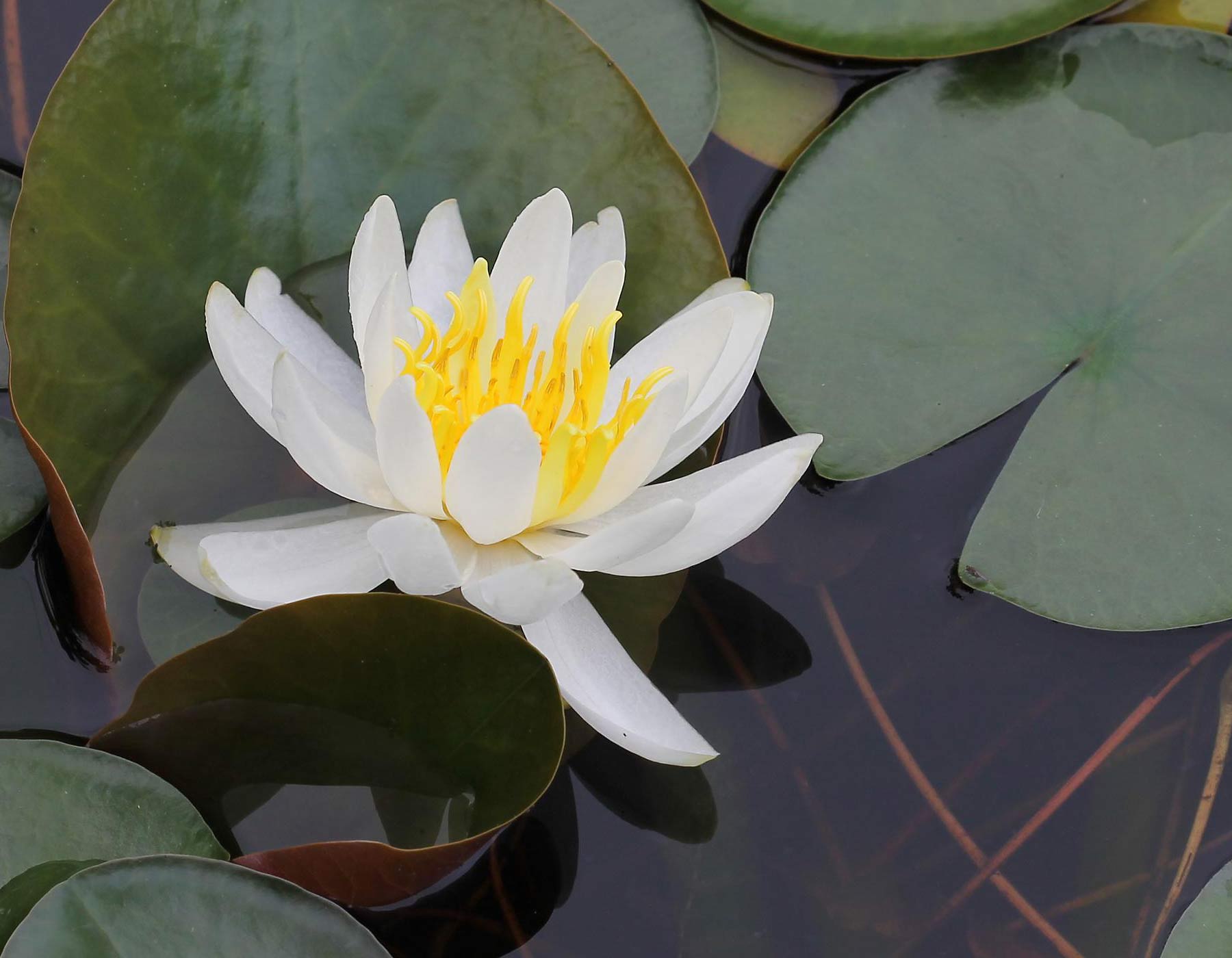Water shield, water lily, and American lotus are common floating leaf plants in healthy Missouri ponds. Unfortunately, once established, they often spread to nuisance levels. Ideally, 10 to 20 percent of a pond’s bottom and surface should be covered in aquatic plants. If more than 20 percent of the pond supports aquatic plants or if vegetation is interfering with pond uses, then mechanical, biological, or chemical control methods should be considered.

Title
Mechanical Control
Shading
This method will kill virtually all aquatic plants under the sheet within 30 days, but watch for future regrowth. Stretch black Mylar plastic (8 millimeters thick) over patches of growth and fasten in place with weights. Puncture the sheet in multiple places to allow gasses to escape.
Weeding
Weeding can be a tiring and wet process, but it is an effective method if consistently practiced. Water shield and water lily can be controlled by pulling or digging to remove new growth at the base of the plants.
American lotus can be effectively controlled through repeated cutting of leaves. Cutting should begin before the first flower buds open in June. If you have a large crop of lotus in a small pond, be careful to remove the majority of the cut leaves to prevent oxygen depletion in the water as they decay.
Deepening pond edges
Aquatic plants, like all other plants, cannot live without sunlight. As a result, the depth of aquatic plants growth is dependent on how deep sunlight penetrates the water — the clearer the water, the deeper plants will grow. You can reduce the severity of plant overgrowth by deepening many of the pond’s shallow areas with a 3-to-1 slope to 4 feet of depth. Light often cannot penetrate below this point. If you can see the bottom of your pond or lake past 5 feet of depth (a common characteristic of water bodies in the Ozarks), deepening the edges may be an impractical plant control method. This technique usually requires that the water level be drawn down so the pond bottom can dry enough to allow access for a bulldozer or backhoe.
If the pond is old and has become shallow due to accumulation of black muck on the bottom, it may be necessary to drain, dry, and deepen the pond. The black muck stores the nutrients that fuel the excessive growth of aquatic plants. All excavated material should be removed from the pond’s watershed so that unwanted seeds, nutrients, and sediment do not wash back into the pond.
Water level drawdown
Control nuisance aquatic plants by draining the pond and exposing the unwanted plants.
- Always leave at least 8 feet of water in the deepest part of the pond to reduce the chance of a winter fish kill.
- Expose the sediments to prolonged freezing and drying for two to four weeks during December, January, and February.
Both freezing and drying can be difficult to achieve due to Missouri’s unpredictable winter weather. If pond sediments remain wet, especially if insulated by a layer of snow, plant roots may not be sufficiently damaged to achieve the desired level of control.
Keep in mind that if the pond does not reach its normal level by spring and water clarity allows light to penetrate many feet below the surface, aquatic plants may grow even deeper than before the drawdown, expanding weed growth.
Minimizing nutrient inputs
Prevent excess nutrients (nitrogen and phosphorus) from washing into lakes and ponds. Aquatic plants can quickly grow to nuisance levels with these extra nutrients. These nutrients accumulate naturally as the pond ages, but some localized nutrients enter the pond through runoff.
Sources of nutrients runoff:
- feedlots
- fertilized fields and yards
- septic tank seepage
- fish food
Filter excess nutrients from runoff water by maintaining a 100-foot or wider buffer strip of grass and trees around the pond’s edge. Construct small silt retention ponds in the watershed to settle out nutrients before they enter the pond. Avoid localized nutrient inputs by tiling or constructing a water diversion terrace below the nutrient source to direct its runoff away from the pond. Also, fence livestock away from the pond’s edge and water them from a tank below the dam.
Title
Biological Control
Grass carp do not effectively control water shield, water lily, or locust. The waxy coating (cuticle) and thick, fibrous stems of these plants make them difficult for grass carp to eat.
Title
Chemical Control
Before using chemicals, you should consider potential contamination of domestic water supplies and waiting periods for watering livestock, eating fish, swimming, and irrigating.
For best results
- Apply herbicides in spring and early summer, when plants are growing rapidly.
- Treat no more than 25–33 percent of the pond at 10- to 14-day intervals.
- Be careful to remove dead plant material following chemical application to prevent lethal levels of low dissolved oxygen.
Chemicals can be expensive and do not provide permanent control, so periodic re-treatments are usually necessary. Please remember that the long-term effects of most herbicides on the environment are not well known.
Download the Aquaguide below for additional information on chemical recommendations and determining the amount of herbicide needed. Contact your local MDC office with any questions.
Title
American Lotus
Excellent Control
- Imazapyr (Habitat, Arsenal, Polaris)
- 2,4-D (Navigate, Weedar 64)
Good-Excellent Control
- Glyphosate (Rodeo, Aquamaster, AquaNeat, Eraser AQ, Refuge)
Good Control
- Endothall (Aquathol K, Aquathol Super K)
- Imazamox (Clearcast)
- Triclopyr (Renovate, Navitrol, Ecotriolopyr)
Title
Water Lilies
Excellent Control
- Fluridone (Sonar, Avast, WhiteCap, Restore, Fluridone)
- 2,4-D (Navigate, Weedar 64)
Good Control
- Glyphosate (Rodeo, Aquamaster, AquaNeat, Eraser AQ, Refuge)
- Imazamox (Clearcast)
- Imazapyr (Habitat, Arsenal, Polaris)
- Penoxsulam (Galleon)
- Triclopyr (Renovate, Navitrol, Ecotriolopyr)
Fair Control
- Bispyribac (Tradewind)
- Flumioxazin (Clipper)
Title
Water Shield
Excellent Control
- Imazapyr (Habitat, Arsenal, Polaris)
- 2,4-D (Navigate, Weedar 64)
Good Control
- Flumioxazin (Clipper)
- Fluridone (Sonar, Avast, WhiteCap, Restore, Fluridone)
- Glyphosate (Rodeo, Aquamaster, AquaNeat, Eraser AQ, Refuge)
- Imazamox (Clearcast)





















